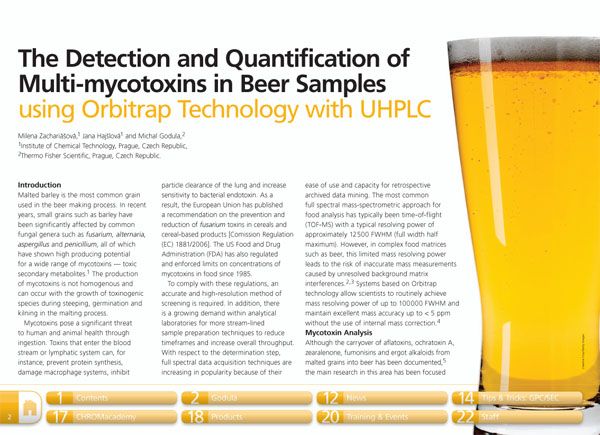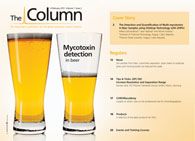The Detection and Quantification of Multi-mycotoxins in Beer Samples using Orbitrap Technology with UHPLC
The Detection and Quantification of Multi-mycotoxins in Beer Samples using Orbitrap Technology with UHPLC.
Malted barley is the most common grain used in the beer making process. In recent years, small grains such as barley have been significantly affected by common fungal genera such as fusarium, alternaria, aspergillus and penicillium, all of which have shown high producing potential for a wide range of mycotoxins — toxic secondary metabolites. The production of mycotoxins is not homogenous and can occur with the growth of toxinogenic species during steeping, germination and kilning in the malting process.
Mycotoxins pose a significant threat to human and animal health through ingestion. Toxins that enter the blood stream or lymphatic system can, for instance, prevent protein synthesis, damage macrophage systems, inhibit particle clearance of the lung and increase sensitivity to bacterial endotoxin. As a result, the European Union has published a recommendation on the prevention and reduction of fusarium toxins in cereals and cereal-based products [Comission Regulation (EC) 1881/2006]. The US Food and Drug Administration (FDA) has also regulated and enforced limits on concentrations of mycotoxins in food since 1985.
To comply with these regulations, an accurate and high-resolution method of screening is required. In addition, there is a growing demand within analytical laboratories for more stream-lined sample preparation techniques to reduce timeframes and increase overall throughput. With respect to the determination step, full spectral data acquisition techniques are increasing in popularity because of their ease of use and capacity for retrospective archived data mining. The most common full spectral mass-spectrometric approach for food analysis has typically been time‑of‑flight (TOF-MS) with a typical resolving power of approximately 12 500 FWHM (full width half maximum). However, in complex food matrices such as beer, this limited mass resolving power leads to the risk of inaccurate mass measurements caused by unresolved background matrix interferences.
Systems based on Orbitrap technology allow scientists to routinely achieve mass resolving power of up to 100 000 FWHM and maintain excellent mass accuracy up to
University of Tasmania Researchers Explore Haloacetic Acid Determiniation in Water with capLC–MS
April 29th 2025Haloacetic acid detection has become important when analyzing drinking and swimming pool water. University of Tasmania researchers have begun applying capillary liquid chromatography as a means of detecting these substances.
Analytical Challenges in Measuring Migration from Food Contact Materials
November 2nd 2015Food contact materials contain low molecular weight additives and processing aids which can migrate into foods leading to trace levels of contamination. Food safety is ensured through regulations, comprising compositional controls and migration limits, which present a significant analytical challenge to the food industry to ensure compliance and demonstrate due diligence. Of the various analytical approaches, LC-MS/MS has proved to be an essential tool in monitoring migration of target compounds into foods, and more sophisticated approaches such as LC-high resolution MS (Orbitrap) are being increasingly used for untargeted analysis to monitor non-intentionally added substances. This podcast will provide an overview to this area, illustrated with various applications showing current approaches being employed.

.png&w=3840&q=75)

.png&w=3840&q=75)



.png&w=3840&q=75)



.png&w=3840&q=75)













